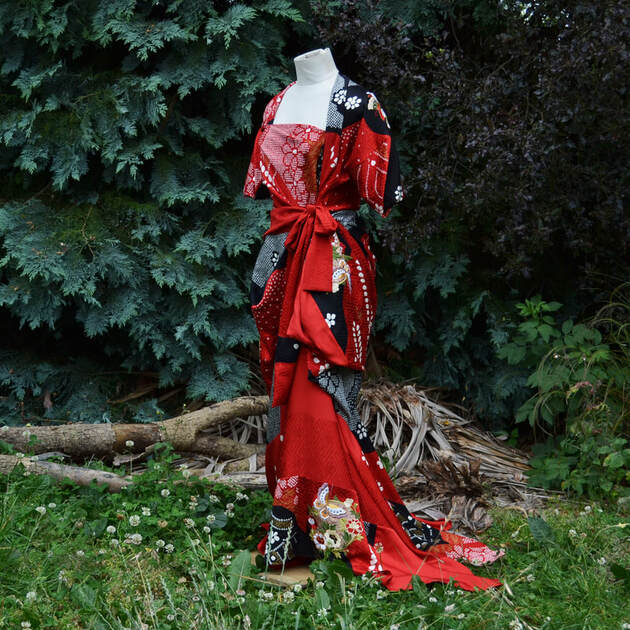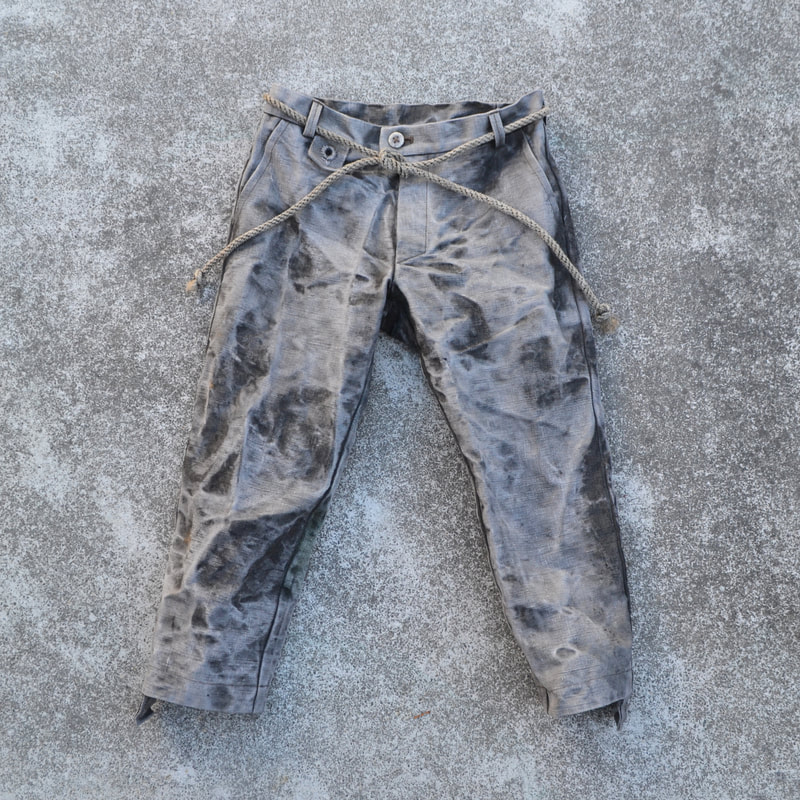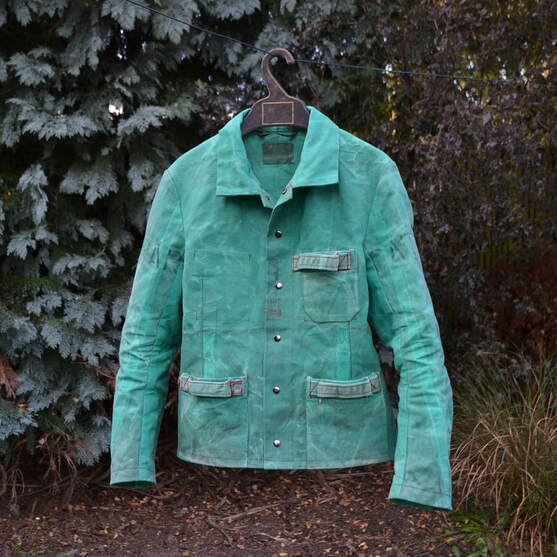#SECONDHANDSEPTEMBER INTERVIEW - 6x4
What started your passion for pre-loved and secondhand?
I learnt to sew when I was a teenager. I would go opshopping with friends and we would alter and personalise our clothes. The excitement of finding great second hand clothing and textiles sparked my interest in using clothing as a mean of self-expression. Being Asian in predominantly pakeha Christchurch I found empowerment in being able to make clothing to explore my sense of identity.
When and how did you start integrating repurposed textiles into your work?
Altering second hand clothing was my introduction to clothing. I learnt to sew at school at around the age of 12 and then I just kept going from then without formal training. Taking clothing apart taught me a lot about construction and patternmaking.
Please tell us a love story about a favourite item/collection that you've created using repurposed clothing or textiles
A client asked me to make her a gown for the opening of an exhibition, for which she was assistant curator, at the Victoria & Albert museum in London. She had been working on this exhibition about Kimono for around 3 years and wanted something special to wear for the opening. She didn't want to wear a traditional kimono but wanted something made from Kimono fabric by a New Zealand designer.
While visiting home she came for her fittings, then chose the antique kimono from Japan and had them sent to my studio. I dismantled them and used the fabric to make her dress. To reference East-Asian garment construction methods I used only long rectangular pattern pieces; draping, twisting, and gathering to create shape. The hem was hand sewn with silk thread running stitch to reference the stitching of the original kimono. I also made her a large ornamental hairpin out of recycled Rimu so that she could have a piece of New Zealand with her. It was a very special project.
I learnt to sew when I was a teenager. I would go opshopping with friends and we would alter and personalise our clothes. The excitement of finding great second hand clothing and textiles sparked my interest in using clothing as a mean of self-expression. Being Asian in predominantly pakeha Christchurch I found empowerment in being able to make clothing to explore my sense of identity.
When and how did you start integrating repurposed textiles into your work?
Altering second hand clothing was my introduction to clothing. I learnt to sew at school at around the age of 12 and then I just kept going from then without formal training. Taking clothing apart taught me a lot about construction and patternmaking.
Please tell us a love story about a favourite item/collection that you've created using repurposed clothing or textiles
A client asked me to make her a gown for the opening of an exhibition, for which she was assistant curator, at the Victoria & Albert museum in London. She had been working on this exhibition about Kimono for around 3 years and wanted something special to wear for the opening. She didn't want to wear a traditional kimono but wanted something made from Kimono fabric by a New Zealand designer.
While visiting home she came for her fittings, then chose the antique kimono from Japan and had them sent to my studio. I dismantled them and used the fabric to make her dress. To reference East-Asian garment construction methods I used only long rectangular pattern pieces; draping, twisting, and gathering to create shape. The hem was hand sewn with silk thread running stitch to reference the stitching of the original kimono. I also made her a large ornamental hairpin out of recycled Rimu so that she could have a piece of New Zealand with her. It was a very special project.
The 6x4 dress mentioned above made from Kimono silk
What is your favourite medium/ textile to work with and why?
I don't really have a favourite, although I tend to use natural fibres. I love natural dyed textiles for their richness and depth of colour.
Do the materials you find secondhand inform the work that you create or do you have an idea of what you'd like to make then find the materials to fit?
It has always been the starting point of my work. Materials that have memories of a previous life are much more exciting to me; there are stains, rips, tears, and limitations on size that must be taken into account when designing. Often I will start with a piece of fabric and try to figure out what it wants to be, rather than starting with an intention and seeking out a textile that would suit. I want to do the materials justice and give them the best second life I possibly can.
Where do you go to source your materials?
Mainly from op-shops or markets but occasionally people very kindly donate fabric that they don't need.
What are your thoughts about upcycling and repurposing old items? Why is it important that we start looking at how we, as a society, can reuse what already exists?
Making clothing is to participate to an industry where there is already such an excess and thousands of tonnes of textile waste going into landfills each year. There is already too much clothing in the world; making more clothing should not be taken lightly. Since I am making more clothing I want to do so in a way that does not contribute to the machine of industry but instead shows the beauty of these discarded materials.
What are some of the challenges when using repurposed textiles?
I make everything myself and each piece is a one-off. Each piece of fabric is unique and its idiosyncrasies must be taken into account in the design process. This requires a lot of problem solving and negotiating; much of the design happens during the making process. I imagine this would be made much more difficult if my patternmaking, cutting, and sewing were outsourced.
And what are some of the joys?
I feel like I am working on a human scale and making things that show the work of a single pair of hands. I like to make things that are within my abilities as one human being. Much of the intimacy of clothing as a human phenomenon comes from the fact that it takes a lot of time and consideration from an individual to make. I like hunting for materials and figuring out their potential, honouring something that would have otherwise gone to waste. I like to be involved in as many parts of the making process as I can and use techniques that give soul to a garment (e.g. hand made buttons from bone and antler, hand sewn buttonholes, natural dyeing, hand darned textile repairs, hand sewing).
I don't really have a favourite, although I tend to use natural fibres. I love natural dyed textiles for their richness and depth of colour.
Do the materials you find secondhand inform the work that you create or do you have an idea of what you'd like to make then find the materials to fit?
It has always been the starting point of my work. Materials that have memories of a previous life are much more exciting to me; there are stains, rips, tears, and limitations on size that must be taken into account when designing. Often I will start with a piece of fabric and try to figure out what it wants to be, rather than starting with an intention and seeking out a textile that would suit. I want to do the materials justice and give them the best second life I possibly can.
Where do you go to source your materials?
Mainly from op-shops or markets but occasionally people very kindly donate fabric that they don't need.
What are your thoughts about upcycling and repurposing old items? Why is it important that we start looking at how we, as a society, can reuse what already exists?
Making clothing is to participate to an industry where there is already such an excess and thousands of tonnes of textile waste going into landfills each year. There is already too much clothing in the world; making more clothing should not be taken lightly. Since I am making more clothing I want to do so in a way that does not contribute to the machine of industry but instead shows the beauty of these discarded materials.
What are some of the challenges when using repurposed textiles?
I make everything myself and each piece is a one-off. Each piece of fabric is unique and its idiosyncrasies must be taken into account in the design process. This requires a lot of problem solving and negotiating; much of the design happens during the making process. I imagine this would be made much more difficult if my patternmaking, cutting, and sewing were outsourced.
And what are some of the joys?
I feel like I am working on a human scale and making things that show the work of a single pair of hands. I like to make things that are within my abilities as one human being. Much of the intimacy of clothing as a human phenomenon comes from the fact that it takes a lot of time and consideration from an individual to make. I like hunting for materials and figuring out their potential, honouring something that would have otherwise gone to waste. I like to be involved in as many parts of the making process as I can and use techniques that give soul to a garment (e.g. hand made buttons from bone and antler, hand sewn buttonholes, natural dyeing, hand darned textile repairs, hand sewing).
A hand dyed pair of trousers made from an army duffle bag with hand made antler button and hand sewn buttonhole and a jacket made from a waxed cotton shipping bag
used to send NCEA school art portfolios.
used to send NCEA school art portfolios.
How do you see potential in some textiles and not in others? What makes an item pop out when you're hunting for materials?
I am interested in textiles that have interesting qualities: weave, yarn, weight, body, movement, pattern, or colour. I like textiles that feel rich with memory, I find they have wider potentials for what they could become.
Overconsumption and over production of new clothing is a huge global issue, particularly with landfills being drowned in textiles that are hardly used before they're discarded. Your creativity supports a welcome alternative to this throwaway culture, what are your thoughts on this issue?
I think it's unfair that ethical responsibilities for massive global issues have been pushed onto consumers. Everything that we consume has ethical problems but the main issues come from industry. Of course we should try to stay educated about these things when it comes to the choices we make but this is often quite overwhelming. It is a privilege to be able to think about the ethics of our consumption. I think bringing things back to an individual human scale is a good way to fight feelings of helplessness and claim back a sense of agency. Learning how to sew or personalise clothing is a great way to take the power out of the hands of industry and reconnect with the cultural importance of dress for humans. I don't have an answer for these issues but I want to make things that feel right for me and that offer a different way of seeing clothing and its making process.
Any other wisdom or words of advice that you'd like to share with people during #secondhandseptember
Clothing is something unique to our species; we should start thinking about how special that is.
I am interested in textiles that have interesting qualities: weave, yarn, weight, body, movement, pattern, or colour. I like textiles that feel rich with memory, I find they have wider potentials for what they could become.
Overconsumption and over production of new clothing is a huge global issue, particularly with landfills being drowned in textiles that are hardly used before they're discarded. Your creativity supports a welcome alternative to this throwaway culture, what are your thoughts on this issue?
I think it's unfair that ethical responsibilities for massive global issues have been pushed onto consumers. Everything that we consume has ethical problems but the main issues come from industry. Of course we should try to stay educated about these things when it comes to the choices we make but this is often quite overwhelming. It is a privilege to be able to think about the ethics of our consumption. I think bringing things back to an individual human scale is a good way to fight feelings of helplessness and claim back a sense of agency. Learning how to sew or personalise clothing is a great way to take the power out of the hands of industry and reconnect with the cultural importance of dress for humans. I don't have an answer for these issues but I want to make things that feel right for me and that offer a different way of seeing clothing and its making process.
Any other wisdom or words of advice that you'd like to share with people during #secondhandseptember
Clothing is something unique to our species; we should start thinking about how special that is.
6x4 is the body of work of an individual who chooses to remain anonymous behind the label. It is the expression of the aesthetic universe this individual wants to create and inhabit. To find out more, visit @6x4online and www.6x4online.com
Keen to hunt out pre-loved textiles to repurpose for yourself? CLICK HERE to order a pre-sale copy of Collector's Anonymous, your handy glovebox sized guide that lists over 1500 antique, secondhand and charity stores around Aotearoa.
Keen to hunt out pre-loved textiles to repurpose for yourself? CLICK HERE to order a pre-sale copy of Collector's Anonymous, your handy glovebox sized guide that lists over 1500 antique, secondhand and charity stores around Aotearoa.


